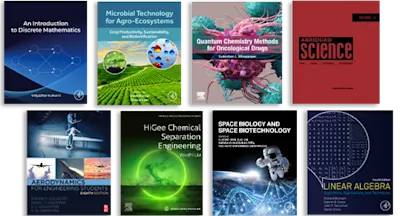
Food Process Engineering and Technology
- 2nd Edition - October 30, 2018
- Author: Zeki Berk
- Language: English
- Hardback ISBN:9 7 8 - 0 - 1 2 - 4 1 5 9 2 3 - 5
- Paperback ISBN:9 7 8 - 0 - 1 2 - 8 1 0 0 5 6 - 1
- eBook ISBN:9 7 8 - 0 - 1 2 - 4 1 5 9 8 6 - 0
The past 30 years have seen the establishment of food engineering both as an academic discipline and as a profession. Combining scientific depth with practical usefulness, this… Read more

- Strong emphasis on the relationship between engineering and product quality/safety
- Links theory and practice
- Considers topics in light of factors such as cost and environmental issues
Food Science and Technology International Series
Dedication
Introduction
“Food is life”
The food process
Batch and continuous processes
Process flow diagrams
References
Chapter 1. Physical Properties of Food Materials
1.1 Introduction
1.2 Mass, volume, density
1.3 Mechanical properties
1.4 Thermal properties
1.5 Electrical properties
1.6 Structure
1.7 Water activity
1.8 Phase transition phenomena in foods
1.9 Optical properties
1.10 Surface properties
1.11 Acoustic properties
References
Chapter 2. Fluid Flow
2.1 Introduction
2.2 Elements of fluid mechanics
2.3 Flow properties of fluids
2.4 Transportation of fluids
2.5 Flow of particulate solids (powder flow)
References
Chapter 3. Heat and Mass Transfer: Basic Principles
3.1 Introduction
3.2 Basic relations in transport phenomena
3.3 Conductive heat and mass transfer
3.4 Convective heat and mass transfer
3.5 Unsteady state heat and mass transfer
3.6 Heat transfer by radiation
3.7 Heat exchangers
3.8 Microwave and radio frequency (RF) heating
3.9 Ohmic heating
References
Chapter 4. Reaction Kinetics
4.1 Introduction
4.2 Basic concepts
4.3 Kinetics of biological processes
4.4 Residence time and residence time distribution
References
Chapter 5. Elements of Process Control
5.1 Introduction
5.2 Basic concepts
5.3 Basic control structures
5.4 The block diagram
5.5 Input, output and process dynamics
5.6 Control modes (control algorithms)
5.7 Physical elements of the control system
References
Chapter 6. Size Reduction
6.1 Introduction
6.2 Particle size and particle size distribution
6.3 Size reduction of solids: basic principles
6.4 Size reduction of solids: equipment and methods
References
Chapter 7. Mixing
7.1 Introduction
7.2 Mixing of fluids (blending)
7.3 Kneading
7.4 In-flow mixing
7.5 Mixing of particulate solids
7.6 Homogenization
7.7 Foaming
References
Chapter 8. Filtration and Expression
8.1 Introduction
8.2 Depth filtration
8.3 Surface (barrier) filtration
8.4 Filtration equipment
8.5 Expression
References
Chapter 9. Centrifugation
9.1 Introduction
9.2 Basic principles
9.3 Centrifuges
9.4 Cyclones
References
Chapter 10. Membrane Processes
10.1 Introduction
10.2 Tangential filtration
10.3 Mass transfer through MF and UF membranes
10.4 Mass transfer in reverse osmosis
10.5 Membrane systems
10.6 Membrane processes in the food industry
10.7 Electrodialysis
References
Chapter 11. Extraction
11.1 Introduction
11.2 Solid–liquid extraction (leaching)
11.3 Supercritical fluid extraction
11.4 Liquid–liquid extraction
References
Chapter 12. Adsorption and Ion Exchange
12.1 Introduction
12.2 Equilibrium conditions
12.3 Batch adsorption
12.4 Adsorption in columns
12.5 Ion exchange
References
Chapter 13. Distillation
13.1 Introduction
13.2 Vapor–liquid equilibrium (VLA)
13.3 Continuous flash distillation
13.4 Batch (differential) distillation
13.5 Fractional distillation
13.6 Steam distillation
13.7 Distillation of wines and spirits
13.8 Pervaporation
References
Chapter 14. Crystallization and Dissolution
14.1 Introduction
14.2 Kinetics of crystallization from solutions
14.3 Polymorphism in lipid crystals
14.4 Crystallization in the food industry
14.5 Dissolution
References
Chapter 15. Extrusion
15.1 Introduction
15.2 The single-screw extruder
15.3 Twin-screw extruders
15.4 Effect on foods
15.5 Food applications of extrusion
References
Chapter 16. Spoilage and Preservation of Foods
16.1 Mechanisms of food spoilage
16.2 Food preservation processes
16.3 Combined processes (the “hurdle effect”)
16.4 Packaging
Additional Reading
Chapter 17. Thermal Processing
17.1 Introduction
17.2 The kinetics of thermal inactivation of microorganisms and enzymes
17.3 Optimization of thermal processes with respect to quality
17.4 Heat transfer considerations in thermal processing
References
Chapter 18. Thermal Processes, Methods and Equipment
18.1 Introduction
18.2 Thermal processing in hermetically closed containers
18.3 Thermal processing in bulk, before packaging
References
Chapter 19. Refrigeration: Chilling and Freezing
19.1 Introduction
19.2 Effect of temperature on food spoilage
19.3 Freezing
19.4 Superchilling
References
Chapter 20. Refrigeration: Equipment and Methods
20.1 Sources of refrigeration
20.2 Cold storage and refrigerated transport
20.3 Chillers and freezers
References
Chapter 21. Evaporation
21.1 Introduction
21.2 Material and energy balance
21.3 Heat transfer
21.4 Energy management
21.5 Condensers
21.6 Evaporators in the food industry
21.7 Effect of evaporation on food quality
References
Chapter 22. Dehydration
22.1 Introduction
22.2 Thermodynamics of moist air (psychrometry)
22.3 Convective drying (air drying)
22.4 Drying under varying external conditions
22.5 Conductive (boiling) drying
22.6 Dryers in the food processing industry
22.7 Issues in food drying technology
22.8 Energy consumption in drying
22.9 Osmotic dehydration
References
Chapter 23. Freeze Drying (Lyophilization) and Freeze Concentration
23.1 Introduction
23.2 Sublimation of water
23.3 Heat and mass transfer in freeze drying
23.4 Freeze drying in practice
23.5 Freeze concentration
References
Chapter 24. Frying, Baking, Roasting
24.1 Introduction
24.2 Frying
24.3 Baking and roasting
References
Chapter 25. Chemical Preservation
25.1 Introduction
25.2 Chemical control of microbial spoilage
25.3 Antioxidants
References
Chapter 26. Ionizing Irradiation and Other Non-Thermal Preservation Processes
26.1 Preservation by ionizing radiations
26.2 High hydrostatic pressure (HHP) preservation
26.3 Pulsed electric fields (PEF)
26.4 Pulsed intense light
References
Chapter 27. Food Packaging
27.1 Introduction
27.2 Packaging materials
27.3 The atmosphere in the package
27.4 Environmental issues
References
Chapter 28. Cleaning, Disinfection, Sanitation
28.1 Introduction
28.2 Cleaning kinetics and mechanisms
28.3 Kinetics of disinfection
28.4 Cleaning of raw materials
28.5 Cleaning of plants and equipment
28.6 Cleaning of packages
28.7 Odor abatement
References
Appendix
Food Science and Technology: International Series List
Index
- Edition: 2
- Published: October 30, 2018
- Language: English
ZB